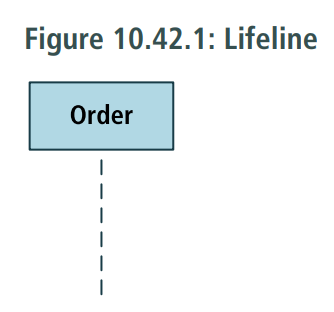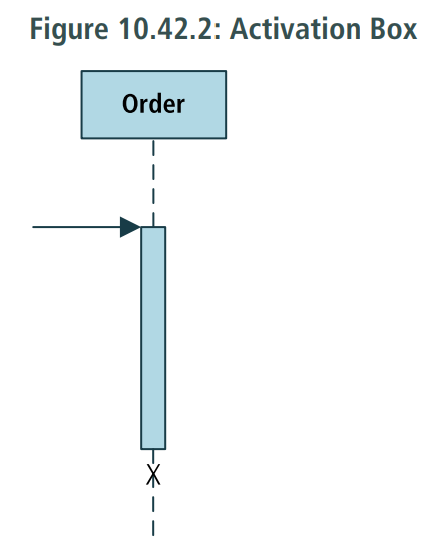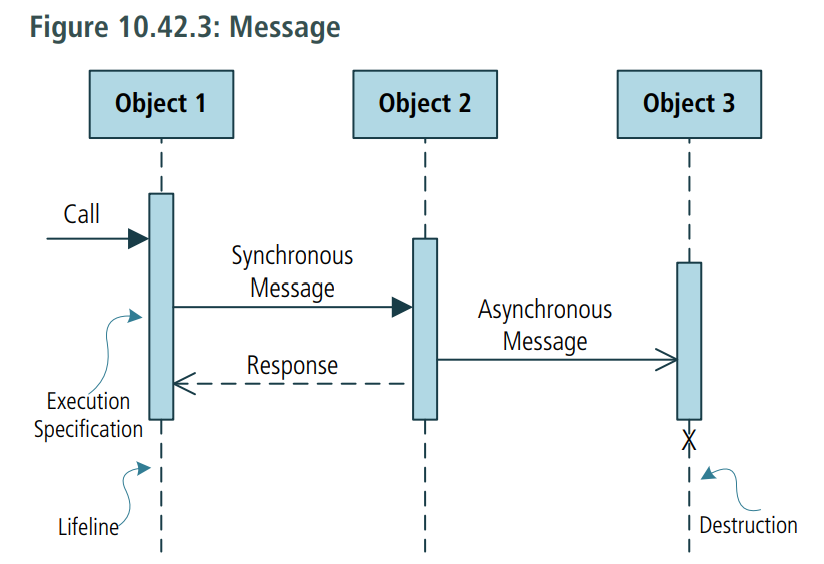10.42.1 Purpose
Sequence diagrams are used to model the logic of usage scenarios by showing the information passed between objects in the system through the execution of the scenario.
10.42.2 Description
A sequence diagram shows how processes or objects interact during a scenario. The classes required to execute the scenario and the messages they pass to one another (triggered by steps in the use case) are displayed on the diagram. The sequence diagram shows how objects used in the scenario interact, but not how they are related to one another. Sequence diagrams are also often used to show how user interface components or software components interact.
The diagram represents information in a horizontal and vertical alignment. The objects that send messages to each other are represented as boxes that are aligned at the top of the page from the left to the right, with each object occupying a column of space on the page bordered by a vertical line stretching down to the bottom of the page. The messages that are sent from one object to the next are represented as horizontal arrows. The order of the messages is represented in a top-down and left-to-right sequence beginning with the first message at the top left of the page and subsequent messages occurring to the right and below. Sequence diagrams are sometimes called event diagrams.
The standard notation for sequence diagrams is defined as part of the Unified Modelling Language™ (UML®) specification.
10.42.3 Elements
.1 Lifeline
A lifeline represents the lifespan of an object during the scenario being modelled in a sequence diagram. The example below shows the object order. A lifeline is drawn as a dashed line that vertically descends from each object box to the bottom of the page.

.2 Activation Box
An activation box represents the period during which an operation is executed. A call to activate is represented by an arrow with a solid arrowhead leading to the activation object. The lifeline can be terminated with an X.

.3 Message
A message is an interaction between two objects. A message is shown as an arrow coming from the activation box of the object that sends the message to the activation box of the object that receives the message.
The name of the message is placed on top of the arrowed line. There are different types of messages:
- Synchronous Call: transfers control to the receiving object. The sender cannot act until a return message is received.
- Asynchronous Call: (also known as a signal) allows the object to continue with its own processing after sending the signal. The object may send many signals simultaneously, but may only accept one signal at a time.

10.42.4 Usage Considerations
.1 Strengths
- Shows the interaction between the objects of a system in the chronological order that the interactions occur.
- Shows the interaction between the objects in a visual manner that allows the logic to be validated by stakeholders with relative ease.
- Use cases can be refined into one or more sequence diagrams in order to provide added detail and a more in-depth understanding of a business process.
.2 Limitations
- Time and effort can be wasted creating a complete set of sequence diagrams for each use case of a system, which may not be necessary.
- Have historically been used for modelling system flows and may be considered too technical in other circumstances.
